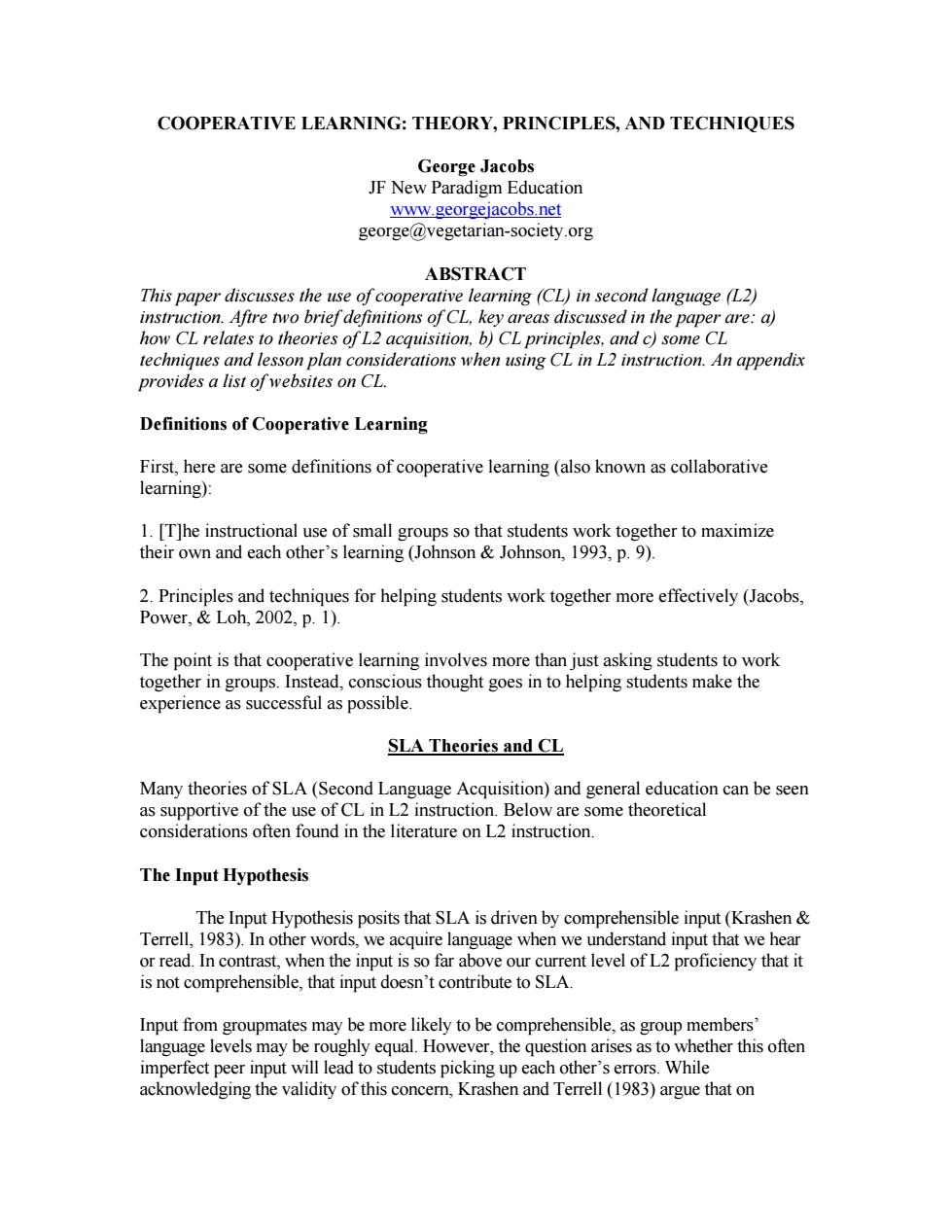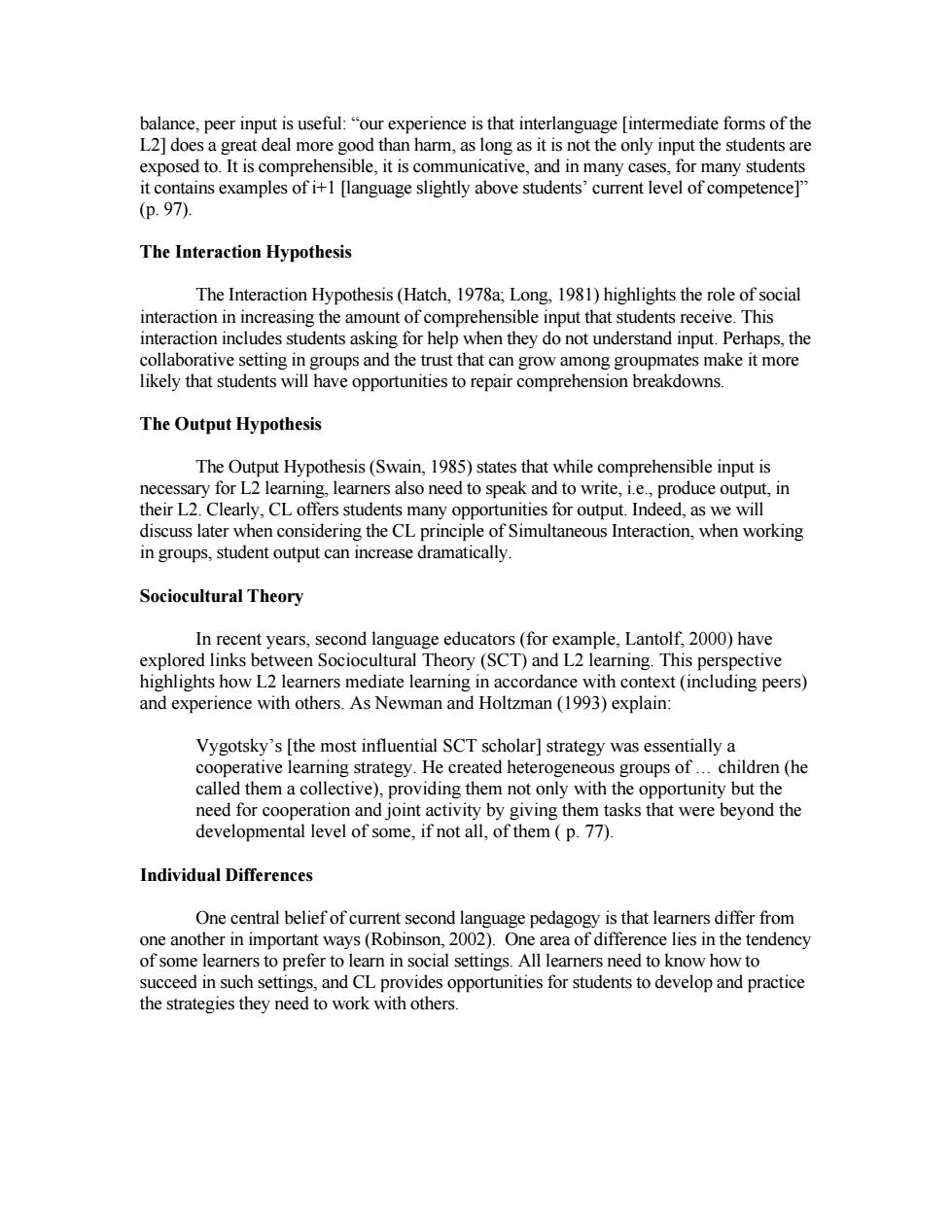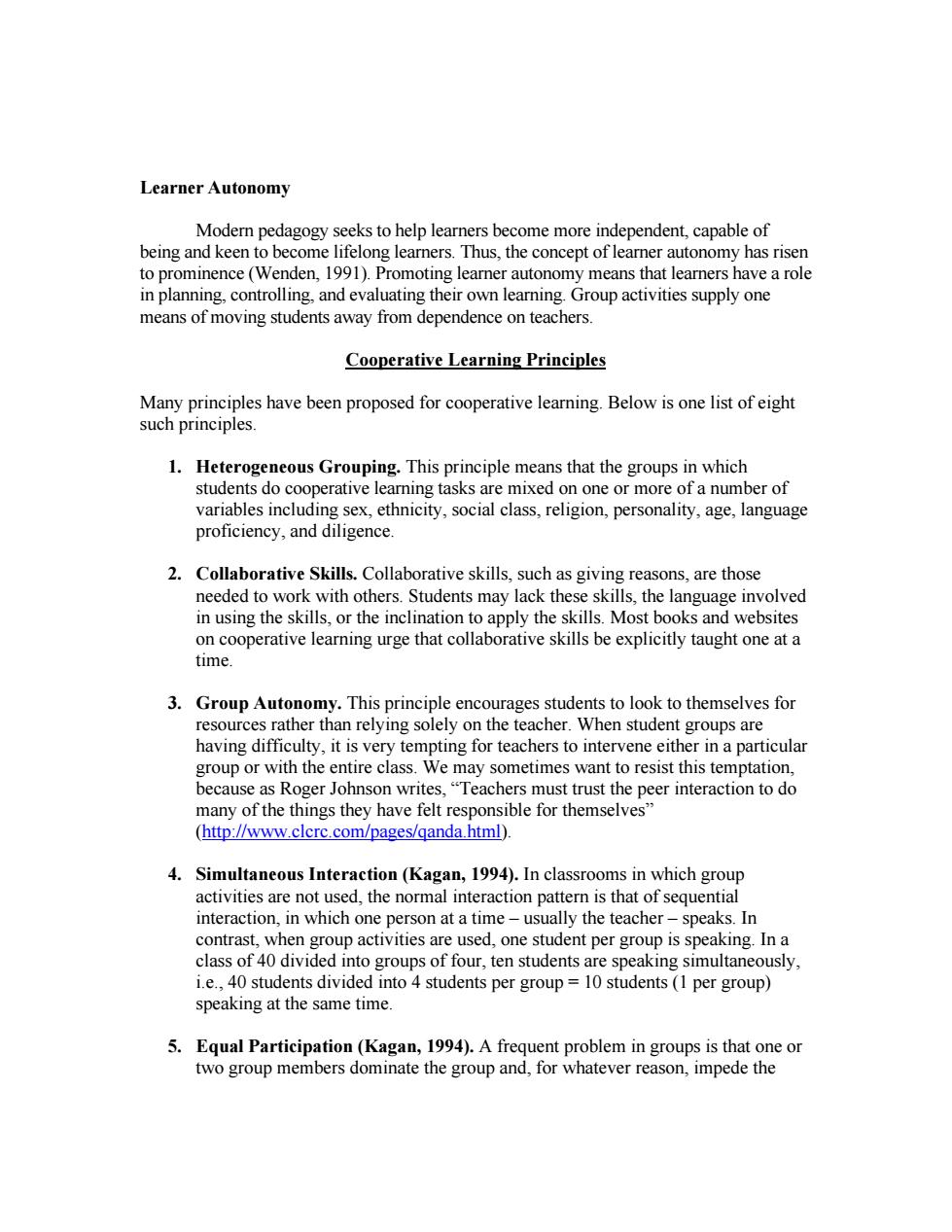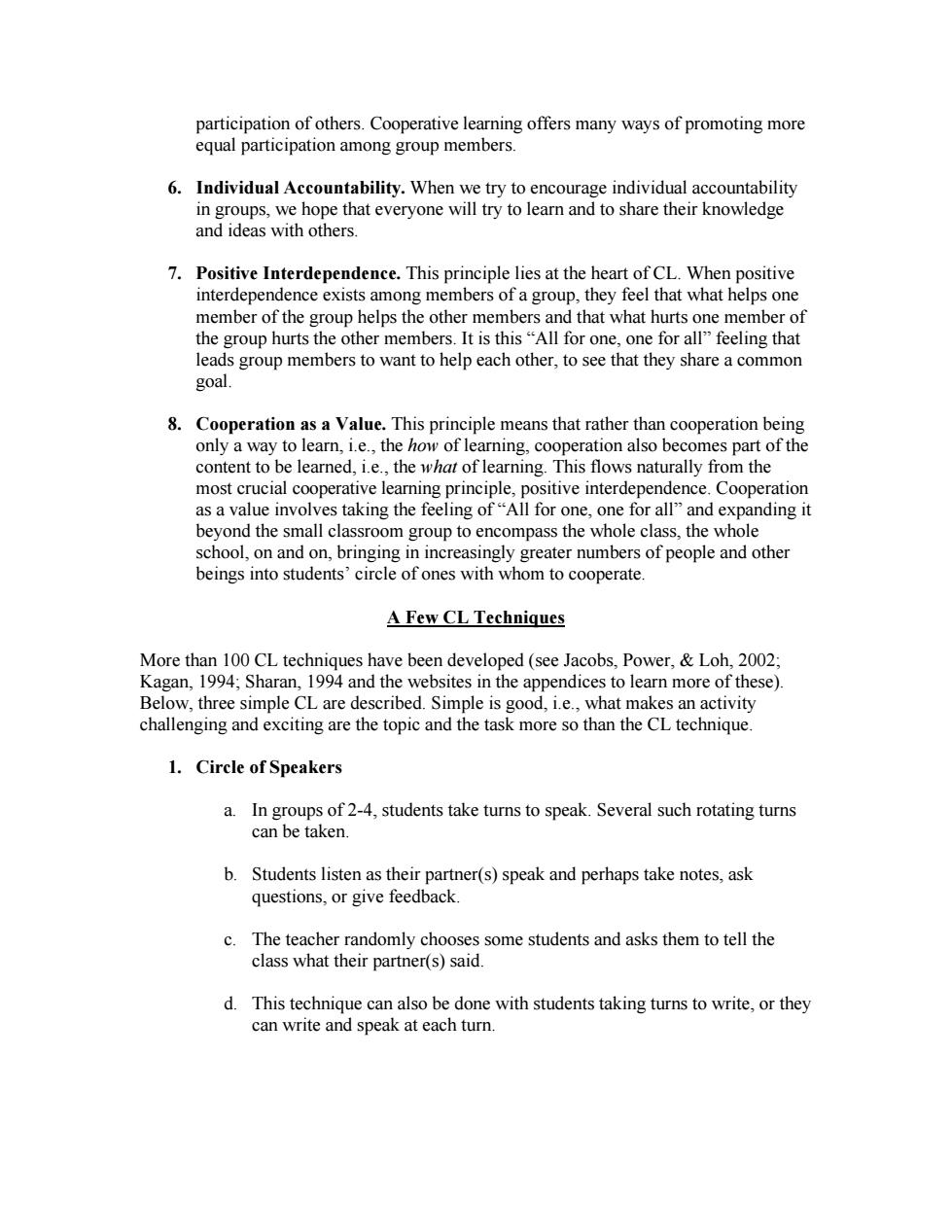
COOPERATIVE LEARNING:THEORY,PRINCIPLES,AND TECHNIQUES George Jacobs JF New Paradigm Education www.georgejacobs.net george@vegetarian-society.org ABSTRACT This paper discusses the use of cooperative learning (CL)in second language (L2) ion.Afre two brief definitions of CL.key areas discussed in the aper are:a) how CL relates to theories of L2 ac when using truction.An appendix ites on Cl Definitions of Cooperative Learning First,here are some definitions of cooperative learning(also known as collaborative learning): [T]he instructional use of small groups so that students work together to maximize their own and each other's learning (Johnson Johnson,1993,p.9). 2.Principles and techniques for helping students work together more effectively (Jacobs Power,Loh,2002,p.1). The point is that cooperative learning involves more than just asking students to work together in groups.Instead,conscious thought goes in to helping students make the experience as successful as possible. SLA Theories and CL Many theories of SLA(Second Lar eral education can be seen as s oportive of the of CL in L2 inst ome theoretical considerati uctio ofte ruction The Input Hypothesis The Input Hypothesis posits that SLA is driven by comprehensible input(Krashen& Terrell,1983).In other words,we acquire language when we understand input that we hear or read.In contrast,when the input is so far above our current level of L2 proficiency that it is not comprehensible,that input doesn't contribute to SLA. Input from groupmates may be more likely to be comprehensible,as group members' language levels may be roughly equal.However,the question arises as to whether this often imperfect peer input will lead to students picking up each other's errors.While acknowledging the validity of this concern,Krashen and Terrell (1983)argue that on
COOPERATIVE LEARNING: THEORY, PRINCIPLES, AND TECHNIQUES George Jacobs JF New Paradigm Education www.georgejacobs.net george@vegetarian-society.org ABSTRACT This paper discusses the use of cooperative learning (CL) in second language (L2) instruction. Aftre two brief definitions of CL, key areas discussed in the paper are: a) how CL relates to theories of L2 acquisition, b) CL principles, and c) some CL techniques and lesson plan considerations when using CL in L2 instruction. An appendix provides a list of websites on CL. Definitions of Cooperative Learning First, here are some definitions of cooperative learning (also known as collaborative learning): 1. [T]he instructional use of small groups so that students work together to maximize their own and each other’s learning (Johnson & Johnson, 1993, p. 9). 2. Principles and techniques for helping students work together more effectively (Jacobs, Power, & Loh, 2002, p. 1). The point is that cooperative learning involves more than just asking students to work together in groups. Instead, conscious thought goes in to helping students make the experience as successful as possible. SLA Theories and CL Many theories of SLA (Second Language Acquisition) and general education can be seen as supportive of the use of CL in L2 instruction. Below are some theoretical considerations often found in the literature on L2 instruction. The Input Hypothesis The Input Hypothesis posits that SLA is driven by comprehensible input (Krashen & Terrell, 1983). In other words, we acquire language when we understand input that we hear or read. In contrast, when the input is so far above our current level of L2 proficiency that it is not comprehensible, that input doesn’t contribute to SLA. Input from groupmates may be more likely to be comprehensible, as group members’ language levels may be roughly equal. However, the question arises as to whether this often imperfect peer input will lead to students picking up each other’s errors. While acknowledging the validity of this concern, Krashen and Terrell (1983) argue that on

balance,peer input is useful:"our experience is that interlanguage [intermediate forms of the L2]does a great deal more good than harm,as long as it is not the only input the students are exposed to.It is comprehensible,it is communicative,and in many cases,for many students it contains examples of i+l [language slightly above students'current level of competence]" (p.97 The Interaction Hypothesis The Interaction Hypothesis(Hatch,1978a;Long.1981)highlights the role of social g th mpre npu stude eive.This ction includ s students asking or hel e n they do no t understan erhaps,the roups and e n grow a ong groupm es make it more likely that students will have opportunities to repair comprehension breakdowns The Output Hypothesis The Output Hypothesis(Swain,1985)states that while comprehensible input is necessary for L2 learning,learners also need to speak and to write,i.e.,produce output,in their L2.Clearly,CL offers students many opportunities for output.Indeed,as we will discuss later when considering the CL principle of Simultaneous Interaction,when working in groups,student output can increase dramatically. Sociocultural Theory In recent vears second language educators (for example Lantolf 2000)have explored links betv een so ciocultural Theory(SCT)and L2 learning.This p highlights how L2 le s mediate learnit in acc rdance with c n) and experience with others.As Newman and Holtzman(1993)exp Vygotsky's [the mo st influential SCT scholar]strategy was esse ive lear creat ed heterogene hildrer n (he providing them not only portunity but th need for cooperation and jo giving them tasks that were beyond the developmental level of some,if not all,of them(p.77) Individual Differences One central belief of current second language pedagogy is that learners differ from one another in important ways(Robinson,2002).One area of difference lies in the tendency of some learners to prefer to learn in social settings.All learners need to know how to succeed in such settings,and CL provides opportunities for students to develop and practice the strategies they need to work with others
balance, peer input is useful: “our experience is that interlanguage [intermediate forms of the L2] does a great deal more good than harm, as long as it is not the only input the students are exposed to. It is comprehensible, it is communicative, and in many cases, for many students it contains examples of i+1 [language slightly above students’ current level of competence]” (p. 97). The Interaction Hypothesis The Interaction Hypothesis (Hatch, 1978a; Long, 1981) highlights the role of social interaction in increasing the amount of comprehensible input that students receive. This interaction includes students asking for help when they do not understand input. Perhaps, the collaborative setting in groups and the trust that can grow among groupmates make it more likely that students will have opportunities to repair comprehension breakdowns. The Output Hypothesis The Output Hypothesis (Swain, 1985) states that while comprehensible input is necessary for L2 learning, learners also need to speak and to write, i.e., produce output, in their L2. Clearly, CL offers students many opportunities for output. Indeed, as we will discuss later when considering the CL principle of Simultaneous Interaction, when working in groups, student output can increase dramatically. Sociocultural Theory In recent years, second language educators (for example, Lantolf, 2000) have explored links between Sociocultural Theory (SCT) and L2 learning. This perspective highlights how L2 learners mediate learning in accordance with context (including peers) and experience with others. As Newman and Holtzman (1993) explain: Vygotsky’s [the most influential SCT scholar] strategy was essentially a cooperative learning strategy. He created heterogeneous groups of … children (he called them a collective), providing them not only with the opportunity but the need for cooperation and joint activity by giving them tasks that were beyond the developmental level of some, if not all, of them ( p. 77). Individual Differences One central belief of current second language pedagogy is that learners differ from one another in important ways (Robinson, 2002). One area of difference lies in the tendency of some learners to prefer to learn in social settings. All learners need to know how to succeed in such settings, and CL provides opportunities for students to develop and practice the strategies they need to work with others

Learner Autonomy Modern pedagogy seeks to help learners become more independent,capable of being and keen to become lifelong learners.Thus,the concept of learner autonomy has risen to prominence(Wenden,1991).Promoting learner autonomy means that learners have a role in planning,controlling,and evaluating their own learning.Group activities supply one means of moving students away from dependence on teachers. Cooperative Learning Principles Many principles have been proposd for cooperative eaming.Below ison list ofeight such principle 1.Heterogeneous Groupi ing.This principle means that the groups in whic stu operative le arning tas one or mor t a number of proficiency,and diligence 2.Collaborative Skills.Collaborative skills,such as giving reasons,are those needed to work with others.Students may lack these skills,the language involved in using the skills,or the inclination to apply the skills.Most books and websites on cooperative learning urge that collaborative skills be explicitly taught one at a time 3.Group Autonomy.This principle encourages students to look to themselves for resources rather than relying solely on the teacher.When student groups are having difficulty,it is very tempting for teachers to intervene either in a particular may sometimes want to resist this temptation, es.Teachers must trust the action to do many of the thi gs they hay folt ros (http://www.clcrc.com/pages/qanda.html) 4.Simultaneous Interaction(Kagan,1994).In classroo activiti es are not on pa em is tha of sequen usua lly the teacher -speaks.In when group activities are used,one student per group is speaking.In a class of 40 divided into groups of four,ten students are speaking simultaneously. i.e.,40 students divided into 4 students per group=10 students(1 per group) speaking at the same time. 5.Equal Participation(Kagan,1994).A frequent problem in groups is that one or two group members dominate the group and,for whatever reason,impede the
Learner Autonomy Modern pedagogy seeks to help learners become more independent, capable of being and keen to become lifelong learners. Thus, the concept of learner autonomy has risen to prominence (Wenden, 1991). Promoting learner autonomy means that learners have a role in planning, controlling, and evaluating their own learning. Group activities supply one means of moving students away from dependence on teachers. Cooperative Learning Principles Many principles have been proposed for cooperative learning. Below is one list of eight such principles. 1. Heterogeneous Grouping. This principle means that the groups in which students do cooperative learning tasks are mixed on one or more of a number of variables including sex, ethnicity, social class, religion, personality, age, language proficiency, and diligence. 2. Collaborative Skills. Collaborative skills, such as giving reasons, are those needed to work with others. Students may lack these skills, the language involved in using the skills, or the inclination to apply the skills. Most books and websites on cooperative learning urge that collaborative skills be explicitly taught one at a time. 3. Group Autonomy. This principle encourages students to look to themselves for resources rather than relying solely on the teacher. When student groups are having difficulty, it is very tempting for teachers to intervene either in a particular group or with the entire class. We may sometimes want to resist this temptation, because as Roger Johnson writes, “Teachers must trust the peer interaction to do many of the things they have felt responsible for themselves” (http://www.clcrc.com/pages/qanda.html). 4. Simultaneous Interaction (Kagan, 1994). In classrooms in which group activities are not used, the normal interaction pattern is that of sequential interaction, in which one person at a time – usually the teacher – speaks. In contrast, when group activities are used, one student per group is speaking. In a class of 40 divided into groups of four, ten students are speaking simultaneously, i.e., 40 students divided into 4 students per group = 10 students (1 per group) speaking at the same time. 5. Equal Participation (Kagan, 1994). A frequent problem in groups is that one or two group members dominate the group and, for whatever reason, impede the

participation of others.Cooperative learning offers many ways of promoting more equal participation among group members. 6.Individual Accountability.When we try to encourage individual accountability in groups,we hope that everyone will try to learn and to share their knowledge and ideas with others. 7.Positive Interdependence.This principle lies at the heart ofCL.When positive interd pe xists among s of a group,they feel that what helps one m ber of th mem nd tha what hurts nber group hurts It is this for one one or al feeling th group members to want to help each other,to see tha at they share a commo goal 8.Cooperation asa Value.This principle means that rather than cooperation being only a way to leamn,i.e.,the how of learning,cooperation also becomes part of the content to be learned,i.e.,the what of learning.This flows naturally from the most crucial cooperative learning principle,positive interdependence.Cooperation as a value involves taking the feeling of"All for one,one for all"and expanding it beyond the small classroom group to encompass the whole class,the whole school,on and on,bringing in increasingly greater numbers of people and other beings into students'circle of ones with whom to cooperate. A Few CL Techniques More than 100 cL techniques have been develoned (see Jacobs power&loh 2002 Kagan.1994:Sharan.1994 and the websites in the a ap endices to learn more of these). Below.three sim i.ie..what makes an activity more so than the Cl techr 1.Circle of Speakers a In group s of 2-4,students take turns to speak.Several such rotating turns can be taken b.Students listen as their partner(s)speak and perhaps take notes,ask questions.or give feedback c.The teacher randomly chooses some students and asks them to tell the class what their partner(s)said. d.This technique can also be done with students taking turns to write,or they can write and speak at each turn
participation of others. Cooperative learning offers many ways of promoting more equal participation among group members. 6. Individual Accountability. When we try to encourage individual accountability in groups, we hope that everyone will try to learn and to share their knowledge and ideas with others. 7. Positive Interdependence. This principle lies at the heart of CL. When positive interdependence exists among members of a group, they feel that what helps one member of the group helps the other members and that what hurts one member of the group hurts the other members. It is this “All for one, one for all” feeling that leads group members to want to help each other, to see that they share a common goal. 8. Cooperation as a Value. This principle means that rather than cooperation being only a way to learn, i.e., the how of learning, cooperation also becomes part of the content to be learned, i.e., the what of learning. This flows naturally from the most crucial cooperative learning principle, positive interdependence. Cooperation as a value involves taking the feeling of “All for one, one for all” and expanding it beyond the small classroom group to encompass the whole class, the whole school, on and on, bringing in increasingly greater numbers of people and other beings into students’ circle of ones with whom to cooperate. A Few CL Techniques More than 100 CL techniques have been developed (see Jacobs, Power, & Loh, 2002; Kagan, 1994; Sharan, 1994 and the websites in the appendices to learn more of these). Below, three simple CL are described. Simple is good, i.e., what makes an activity challenging and exciting are the topic and the task more so than the CL technique. 1. Circle of Speakers a. In groups of 2-4, students take turns to speak. Several such rotating turns can be taken. b. Students listen as their partner(s) speak and perhaps take notes, ask questions, or give feedback. c. The teacher randomly chooses some students and asks them to tell the class what their partner(s) said. d. This technique can also be done with students taking turns to write, or they can write and speak at each turn

2.Write-Pair-Switch a.Each student works alone to write answers b.In pairs.students share answers. c.Students switch partners and share their former partner's ideas with their new partner. 3.Ouestion-and-Answer pairs a.Ss work alone to write one or more questions b.They write answers to their questions on a separate sheet of paper c.Ss exchange questions but not answers d.After Ss have answered their partner's questions,they compare answers. CL Lesson Plan Considerations Cooperative learning represents a major change from teacher-fronted instruction and, therefore,raises new issues that educators need to consider(Cohen,1994).At the same time,using CL does not mean abandoning teacher-fronted mode;it means combining various modes of learning.Below are five issues that many L2 teachers raise when they undertake or even contemplate undertaking CL. 1.Difficulty level Diffculty level of activities may be the largest stumbling block to successfuCLuse. Especially when beginn ng with CL.the task should be ne so that students can feel comfortable and confident working in grou ps.Ideas to consider here nclude startin sy tasks ying es so tha stude ooruhean provide hel when ed ey will rovid ing examples o t groups are ing asked to 2.Sponge activities Often some groups or group members will finish before others.It may be useful for teachers to be prepared with extra activities to"soak up"this extra time,in a way similar to that in which a sponge soaks up extra water.Some ideas include doing homework or extensive reading,helping other individuals or groups who have not yet finished,comparing answers with others who have finished,and doing an enrichment activity such as creating similar tasks as is done in Question-and-Answer Pairs
2. Write-Pair-Switch a. Each student works alone to write answers. b. In pairs, students share answers. c. Students switch partners and share their former partner’s ideas with their new partner. 3. Question-and-Answer Pairs a. Ss work alone to write one or more questions. b. They write answers to their questions on a separate sheet of paper. c. Ss exchange questions but not answers. d. After Ss have answered their partner’s questions, they compare answers. CL Lesson Plan Considerations Cooperative learning represents a major change from teacher-fronted instruction and, therefore, raises new issues that educators need to consider (Cohen, 1994). At the same time, using CL does not mean abandoning teacher-fronted mode; it means combining various modes of learning. Below are five issues that many L2 teachers raise when they undertake or even contemplate undertaking CL. 1. Difficulty level Difficulty level of activities may be the largest stumbling block to successful CL use. Especially when beginning with CL, the task should be an easily doable one, so that students can feel comfortable and confident working in groups. Ideas to consider here include starting CL with easy tasks, carefully clarifying procedures so that students know what they will be doing, providing examples of what groups are being asked to do, and monitoring groups so that teachers can provide help when needed. 2. Sponge activities Often some groups or group members will finish before others. It may be useful for teachers to be prepared with extra activities to “soak up” this extra time, in a way similar to that in which a sponge soaks up extra water. Some ideas include doing homework or extensive reading, helping other individuals or groups who have not yet finished, comparing answers with others who have finished, and doing an enrichment activity such as creating similar tasks as is done in Question-and-Answer Pairs